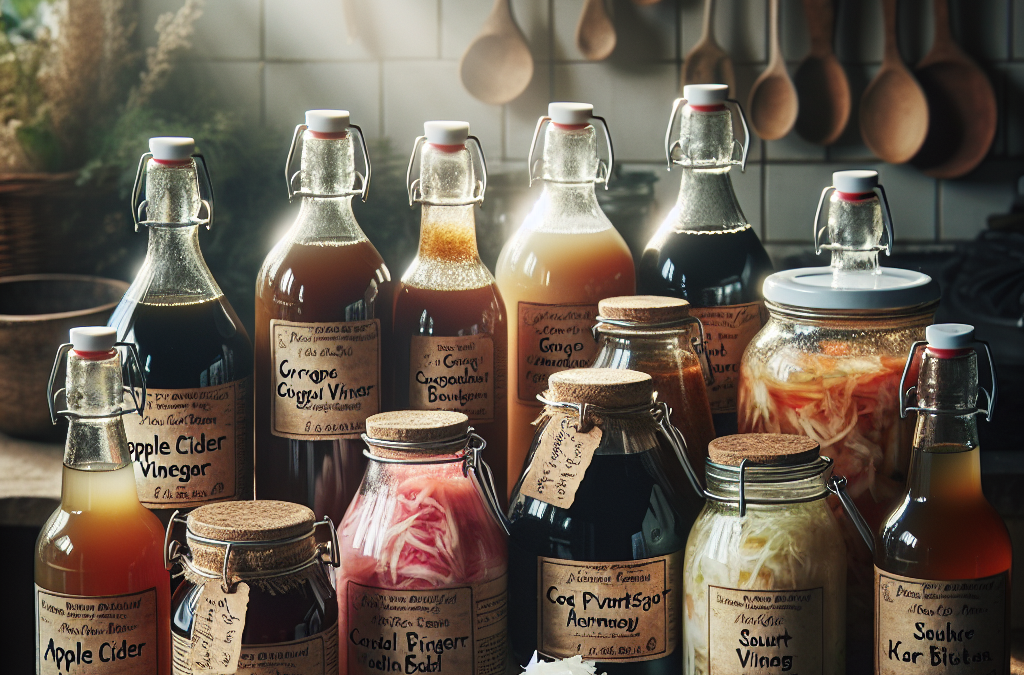1. Health Benefits
Boosting Digestion
One of the first things I noticed when I started incorporating organic vinegars and ferments into my routine is the improvement in my digestion. It’s wild how these natural products can work wonders for gut health. Organic apple cider vinegar, for instance, is packed with enzymes that help break down food more efficiently.
Moreover, the probiotics found in fermented foods can help balance the gut microbiome. When I’ve been consistent with my intake, I feel lighter and more energized. My stomach’s been a lot happier, which we all know can set the tone for the entire day.
Not to forget, these benefits aren’t just about feeling good; they also play a role in boosting your immune system. Strong digestive health can lead to better overall wellness, which is something I definitely advocate for in my life.
Lowering Blood Sugar Levels
Another benefit I’ve found intriguing is how organic vinegars can help with blood sugar management. It’s almost like having a little bit of nature’s magic in a bottle. Research has shown that vinegar can improve insulin sensitivity and lower blood sugar spikes after meals.
When I’ve had a heavy meal, taking a tablespoon of apple cider vinegar diluted in water has made a noticeable difference in how I feel afterward. It’s straightforward and can easily be added to your daily routine. Plus, it’s a great way to satisfy any cravings for something tangy!
Ultimately, managing blood sugar levels can be a game changer for energy levels throughout the day. I’ve noticed that when my blood sugar is stable, I can focus better, not to mention stave off those afternoon slumps!
Weight Loss Support
Let’s be real here; weight management can be a struggle for many. Organic vinegars, particularly apple cider vinegar, have been my little secret weapon. There’s something satisfying about how a splash of vinegar can help curb cravings and keep my appetite in check.
I’ve experimented with adding a bit of vinegar to my salads, and it’s not just healthy; it adds a zing to my meals! Plus, the acetic acid in vinegar helps promote feelings of fullness, which is perfect if you tend to snack more than you’d like.
For anyone looking to shed some pounds, incorporating organic vinegar into meals is a practical strategy. Just remember, it’s not a magic pill, but it can complement a balanced diet quite well!
2. Culinary Versatility
Flavor Enhancer
If there’s one thing you need to know about organic vinegars, it’s that they are incredible flavor enhancers. I love tossing salads with a splash of balsamic vinegar, and trust me, it transforms an average salad into a gourmet delight. It adds layers of flavor that are just unmatched.
Not to mention, the right kind of vinegar can make or break a dish. Whether it’s a tangy kick in a marinade or a sweet note in a reduction, I’ve learned over time that having a variety of organic vinegars in my pantry is a must. It turns every meal into an opportunity for creativity!
You can also experiment with different ferments. Kimchi or sauerkraut can add crunch and zest to sandwiches and tacos. Once you get started, the culinary possibilities are endless, and it makes cooking even more enjoyable!
Preserving Ingredients
One of the coolest things about organic vinegars is their preservation properties. Now, I’m no pro at canning, but I’ve dabbled in pickling. The way vinegar can transform fresh vegetables into zesty pickles is just plain magic. It’s like creating mini jars of joy that last ages!
It’s super practical, especially if you have an excess of seasonal veggies. I’ve pickle radishes and cucumbers with a simple vinegar brine, and they’ve become staples in my fridge. They’re great for adding crunch to meals and snacks.
Plus, having those pickled goodies on hand gives you a quick way to boost nutrient intake in your meals. It’s a win-win for flavor and nutrition!
Creative Uses in Cooking
Don’t limit yourself to just salads and pickling! Organic vinegars can be used in so many unexpected ways. For instance, I’ve tossed some white wine vinegar into sautéed vegetables, and wow, what a difference!
You can also use vinegars in baking! Surprising right? A splash of apple cider vinegar in certain recipes can enhance the leavening process, making your baked goods fluffy. It’s a neat trick I learned that adds a unique flavor too.
Also, don’t forget about their use in marinades. Combining various organic vinegars with herbs and oils gives you a tasty base to bring out the best in meats and tofu. Every meal becomes a culinary adventure!
3. Lifestyle Compatibility
Natural and Organic Choices
Choosing organic is something I’m passionate about. Knowing that I’m supporting sustainable practices by using organic vinegars and ferments makes a big difference in how I feel about my dietary choices. It just feels right.
Organic products are less likely to contain harmful additives or pesticides, which is crucial for my health and well-being. Plus, it’s great to support farmers who prioritize natural growing methods. It connects me to the source of my food, and I really appreciate that.
Furthermore, the transparency that comes with organic products gives me peace of mind when cooking and eating. I know what I’m putting into my body, and that’s an empowering feeling.
Ethical Consumption
As I’ve learned more about food sourcing, I realize how important ethical consumption is. Choosing organic products usually means you’re more attuned to where your food comes from, and that helps support fair trade practices.
Organic vinegars and ferments often come from smaller, local producers. By supporting them, I’m contributing to local economies and sustainability efforts. It’s satisfying to know that my dietary choices have a positive impact.
Also, being mindful about consumption aligns with my health goals. It may be small, but every little effort counts towards living a more conscious lifestyle.
Support for Local Farmers
Whenever I can, I like to buy my organic vinegars and ferments from local farmers’ markets or co-ops. It’s a fantastic way to support the community and ensure freshness. Plus, I always end up chatting with the producers; it’s nice to put a face to the food!
Get Certified Organic Whole Food Nutrition – Nutrient Dense Supplement
Often, local artisans produce unique flavors that you can’t find in regular stores. I’ve discovered some amazing small-batch vinegar makers that have brought new layers of taste to my cooking.
Investing in local products helps maintain vibrant communities. I encourage everyone to check out local options; you might find a hidden gem that turns into your new obsession!
4. Environmental Impact
Less Packaging Waste
One hidden perk of organic vinegars and ferments is the reduced packaging waste associated with them. By opting for bulk buying or refilling options at local stores, I’ve been able to cut back on my use of single-use plastics. It makes me feel like I’m doing my part!
Many organic brands prioritize eco-friendly packaging, which aligns with my values about reducing environmental impact. I’m always on the lookout for brands that take extra steps to reduce their carbon footprint.
Implementing these small changes contributes to a healthier planet, and I believe we all have a role in making sustainable choices whenever possible.
Encouraging Biodiversity
Investing in organic products usually supports biodiversity. Organic farming practices tend to work more harmoniously with nature, which encourages a variety of plants and animals to thrive. This connectedness to nature is something I truly value.
Choosing organic ferments often means supporting heirloom varieties and traditional methods that promote genetic diversity. It’s fascinating how these practices enhance the flavor and nutritional profile of the products we consume!
It’s not just about what’s on my plate; it’s about supporting a sustainable ecosystem. By choosing organic, I feel a sense of connection to the natural world, which enriches my life.
Supporting Sustainable Practices
When I purchase organic vinegars and ferments, I know I’m backing farming practices that prioritize the earth’s health. Organic methods avoid chemical pesticides, which can harm wildlife and pollute the environment.
By supporting these practices, I’m contributing to a more sustainable food system. It’s something I think about often – how the choices I make today can lead to a greener tomorrow.
Additionally, I encourage friends and family to consider these options. It’s gratifying to share knowledge on sustainability and inspire others to think about where their food comes from.
5. Unique Cultural Engagement
Exploring Global Traditions
Diving into the world of organic ferments has opened my eyes to so many different cultures. Products like kombucha or miso are rooted in rich traditions that I values! It’s fascinating to learn how these fermenting methods have been passed down through generations.
This engagement allows me to appreciate the history and craftsmanship involved in creating these products. Understanding the roots of food deepens my culinary experience and appreciation.
Each time I try a new ferment or vinegar variety, I feel connected to different parts of the world. It’s like a passport to new flavors without ever leaving my kitchen!
Facilitating Cultural Exchange
When diving into organic vinegars and ferments, I find myself participating in broader dialogues about food culture. Local food fairs or workshops celebrating fermenting practices are fantastic experiences that facilitate exchange and learning.
Sharing these experiences with others fosters community and understanding. I love discussing traditional methods and discovering how they’ve been adapted in various cuisines.
It’s enriching to recognize how food brings people together, transcending borders and creating meaningful connections among diverse communities. Each jar of kimchi or bottle of vinegar tells a story!
Inspiring Personal Creativity
Exploring organic vinegars and ferments has unleashed my own creativity in the kitchen. I’ve begun tinkering with flavors, blending different ferments, and slightly altering traditional recipes to create something uniquely mine.
This journey has sparked spontaneity in cooking that I relish. It encourages me to step outside of my culinary comfort zone, experimenting with flavors and textures.
Furthermore, creativity in the kitchen can be so rewarding! There’s nothing quite like sharing a dish that’s not only delicious but also reflects your personal touch and learning along the way.
FAQ
What types of organic vinegars are best for health benefits?
Organic apple cider vinegar is one of the most recommended for health benefits, especially for digestion and blood sugar management. You can also consider balsamic and rice vinegars, as they offer unique advantages and flavors!
How do I incorporate ferments into my diet?
Start simple! You can mix fermented foods like kimchi or sauerkraut into meals, use them as toppings, or even enjoy them as snacks. Experimenting with different types can help you find options you enjoy!
Can organic vinegars help with weight loss?
Yes! Organic vinegars can help curb cravings and increase feelings of fullness, which may support weight loss efforts when combined with a balanced diet and exercise.
Are there any side effects of consuming vinegar?
While generally safe, consuming large amounts of vinegar can cause digestive issues or damage tooth enamel. It’s best to dilute vinegar in water or mix it with foods to enjoy its benefits safely.
Where can I find quality organic vinegars and ferments?
Look for local farmers’ markets, health food stores, or organic sections in supermarkets. You may also find great options online, ensuring you’re choosing products from reputable brands!




